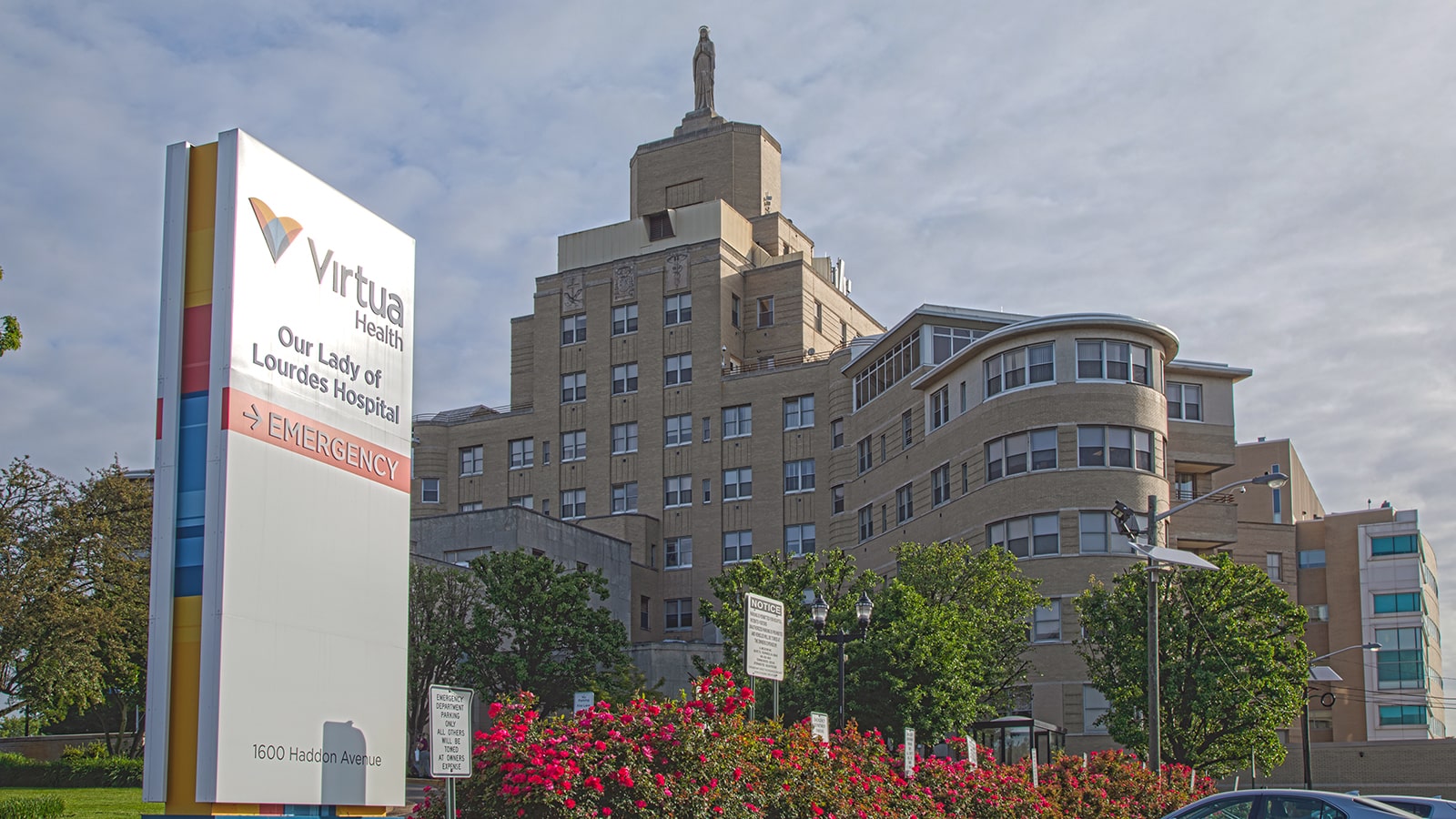Transcatheter Aortic Valve Replacement (TAVR)
If you have severe aortic stenosis, TAVR may be a good option for you. Your Virtua team will help guide you through every step.

Transcatheter aortic valve replacement (TAVR) is a minimally invasive procedure to treat aortic stenosis. Your Virtua heart valve specialists will focus on your goals for treatment—tailoring your care to your specific needs.
What is TAVR?
When you have severe aortic stenosis, TAVR may be a good option to prolong your life and improve your symptoms. In fact, about 97% of Virtua patients who have TAVR report an improvement in their quality of life after TAVR.
The TAVR procedure involves replacing your aortic valve to improve blood flow. The procedure itself takes about one to two hours. And you’ll be in the hospital for just one to two days after the procedure.
Here’s you can expect with TAVR:
- You’ll start by being sedated to allow you to sleep and stay comfortable during the procedure.
- Your interventional cardiologist will insert a catheter (a small, flexible tube) through an artery in your groin. The catheter will have the replacement valve on it.
- Your provider will thread the catheter to your heart.
- They’ll then position the new valve into your narrowed aortic valve—opening the valve and restoring blood flow.
- After the procedure, you’ll be moved to a recovery room and monitored as you come out of sedation.
- You’ll spend one to two days in the hospital for monitoring.
Am I a Candidate for TAVR?
TAVR was initially only an option for a people considered too high risk for open-heart surgery. Today, however, anyone who has aortic stenosis may be a candidate for TAVR.
TAVR could be right for you if you meet any of these criteria:
- You have severe aortic stenosis
- You’re 70 years old or older
- You have had open-heart surgery in the past
- You have had valve replacement in the past
- You have other conditions that make open-heart surgery too risky
- You have mobility issues (e.g., difficulty walking) that would make rehabilitation difficult
Because TAVR is newer than open-heart surgery, more research is needed to determine how long the valve will last. However, early data suggests valves replaced through TAVR perform just as well as surgical valves.
If TAVR is Not an Option
If TAVR is not a good option for you, your care team may recommend valve replacement with open-heart surgery.
Open-heart surgery may be a better option if:
- You’re 65 or younger
- You have bicuspid aortic stenosis with calcifications
- You have coronary obstruction
- You have blockages in your arteries
- You have a stent
With open-heart valve replacement, your new valve should be good for about 10 to 12 years.
Virtua TAVR Specialists
The heart valve team at Virtua includes interventional cardiologists and heart surgeons who specialize in TAVR.
Our Approach to TAVR
Your Virtua interventional cardiologists and heart surgeons work with each other—and you—to determine if TAVR is right for you.
While TAVR is minimally invasive, it is still a major heart procedure. That’s why your team at Virtua makes sure that you understand all aspects of aortic stenosis and the procedure.
To do this, you and your providers will discuss:
- Your symptoms and quality of life
- Results of your tests and imaging (e.g., CT scan, echocardiogram)
- Your goals for treatment
- Your overall health history
- How TAVR works
- The risks and benefits of TAVR
- How TAVR could help improve your symptoms and prolong your life
- Any questions you have about your condition and the procedure
Together, you and your care team will make a shared decision to move forward with TAVR.
Benefits of TAVR
One of the biggest benefits of TAVR is recovering is easier than open-heart surgery recovery
Our patients typically experience faster return to activity and less pain with TAVR. Other benefits of TAVR include:
- Minimal days in the hospital: You’ll spend just 1-2 days in the hospital after TAVR. In fact, about 95% TAVR patients at Virtua go home after just one night.
- Lower risk of complications: With TAVR, there is a lower risk for complications like stroke during the procedure compared to open-heart surgery.
- Back to activity: After your TAVR, you can typically resume regular activity within seven to 10 days.
What to Expect for Follow-up Care
Your Virtua valve care team will continue to monitor your progress and recovery after TAVR. This is what you can expect for your follow-up care plan:
- 24 hours after you leave the hospital: A Virtua nurse navigator will call to check in on you and address any concerns. They will provide guidance and answer your questions.
- One week after TAVR: You’ll return to our clinic for an appointment to check how your incision site is healing. You’ll also have time to ask any questions you may have.
- 30 days after TAVR: You’ll have an echocardiogram to ensure the valve is functioning properly. Then you’ll meet with your interventional cardiologist to discuss how you’re feeling and your overall quality of life.
- After 30 days: You should continue to feel better and will likely not need any additional follow up until your one-year visit. However, your valve care team is available any time to address any questions or concerns.
- One year after TAVR: At this appointment, you’ll have another echocardiogram to ensure the valve is still functioning well. You’ll meet with your interventional cardiologist to discuss your test results and your overall quality of life.

Virtua TAVR Locations
We offer TAVR at Virtua Our Lady of Lourdes Hospital in Camden. And you can do your work-up and follow-up appointments at Virtua locations throughout South Jersey.
The Virtua Difference for TAVR
The highest level of expertise
Virtua is high-volume TAVR center, performing more than 1,000 TAVR procedures since 2013. With this expertise, our heart valve team takes a more minimalistic approach to TAVR — making it easier on our patients. For instance, we avoid using general anesthesia or a Foley catheter for TAVR, significantly reducing the risk for complications.
The highest level of expertise
Virtua is high-volume TAVR center, performing more than 1,000 TAVR procedures since 2013. With this expertise, our heart valve team takes a more minimalistic approach to TAVR — making it easier on our patients. For instance, we avoid using general anesthesia or a Foley catheter for TAVR, significantly reducing the risk for complications.
Efficient, convenient work-up
You’ll need several tests to prepare for the procedure. And we focus on getting you through the work-up as quickly and conveniently as possible. While this can take two to three months at other health systems, we’ll complete your workup within about four weeks. That means you’ll go from diagnosis to treatment as quickly as possible.
Efficient, convenient work-up
You’ll need several tests to prepare for the procedure. And we focus on getting you through the work-up as quickly and conveniently as possible. While this can take two to three months at other health systems, we’ll complete your workup within about four weeks. That means you’ll go from diagnosis to treatment as quickly as possible.
Leaders in TAVR research
Virtua’s TAVR providers participate and lead clinical trials and research looking at ways to further improve TAVR. For instance, we’re the only site in South Jersey participating in the COMPLETE TAVR trial. This trial focuses on treating people who have aortic stenosis and coronary artery disease with TAVR and medications.
Leaders in TAVR research
Virtua’s TAVR providers participate and lead clinical trials and research looking at ways to further improve TAVR. For instance, we’re the only site in South Jersey participating in the COMPLETE TAVR trial. This trial focuses on treating people who have aortic stenosis and coronary artery disease with TAVR and medications.
Getting you moving after TAVR
Our goal is to get you up and moving as soon as possible after your TAVR procedure. Studies show that moving around and walking shortly after TAVR helps lower your risk for deconditioning (loss of muscle mass). It also helps you get back to normal activity more quickly.
Getting you moving after TAVR
Our goal is to get you up and moving as soon as possible after your TAVR procedure. Studies show that moving around and walking shortly after TAVR helps lower your risk for deconditioning (loss of muscle mass). It also helps you get back to normal activity more quickly.
Care for complex cases
Virtua offers options for even the most complicated patients. If you’ve been turned down for TAVR from another center, Virtua structural cardiologists and cardiac surgeons offer second opinions. Their level of expertise often allows them to offer you options not widely available.
Care for complex cases
Virtua offers options for even the most complicated patients. If you’ve been turned down for TAVR from another center, Virtua structural cardiologists and cardiac surgeons offer second opinions. Their level of expertise often allows them to offer you options not widely available.
Is TAVR is a good option for you?
Our experienced heart valve team will work with each other and you to determine if TAVR is right for you.
